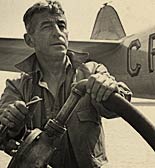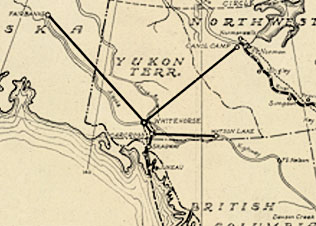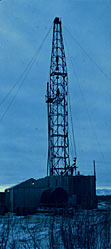Canol
Dedication ceremonies for the Canol refinery in Whitehorse, April 1944. Oil flowed until March 1945. (view more details)

At the height of the frenzied wartime construction of the Alaska Highway, yet another project was begun in northwestern Canada. Canol, short for Canadian American Norman Oil Line, was a pipeline system intended to provide fuel for the Alaska Highway and the Northwest Staging Route. Concerns about Japanese attacks on shipping lanes in the Pacific Ocean triggered the need for a source of fuel that was domestic and inland, protected from enemy threats. The oil field at Norman Wells in the Northwest Territories’ Mackenzie Valley had nine wells producing a crude oil that would flow at temperatures to -70 degrees Fahrenheit. To be cost effective, the field would be required to produce 3,000 barrels per day, well within its potential.
Guy Blanchet surveyed the route for the Canol pipeline with... (view more details)

The original Canol project grew to include 6 separate projects (although Canol 5 was never approved or completed):
- Canol 1
- – Norman Wells to Johnson’s Crossing then along the Alaska Highway to Whitehorse: road, pipeline and telephone lines
- Canol 2
- – Skagway to Whitehorse: pipeline (for oil shipped to Skagway port)
- Canol 3
- – Whitehorse to Fairbanks: pipeline
- Canol 4
- – Whitehorse to Watson Lake: pipeline
- Canol 5
- – Fairbanks to Nenana: pipeline
- Canol 6
- – Peace River to Norman Wells: winter trail to transport supplies and equipment necessary for Canol 1
Three agencies were responsible for delivering the crude oil to a refinery in Whitehorse: the U.S. Army Engineers; Bechtel-Price-Callahan, a consortium of American contractors; and Imperial Oil Limited. Imperial Oil drilled additional wells at Norman Wells; the U.S. Army built the Canol Road; and Bechtel-Price-Callahan constructed the pipelines, installed storage facilities, and developed a refinery at Whitehorse.
This map shows the various aspects of the Canol project including the pipeline and transportation routes. No date. (view more details)

The plan was to have oil flowing by the fall of 1942, but the logistics of moving equipment and supplies to Norman Wells and the remote Canol route proved even more difficult than the construction of the Alaska Highway. Eventually, sixteen hundred miles of pipeline and telephone lines were completed by February 16, 1944 at a total cost of $134,000,000 – five times the estimated cost.


